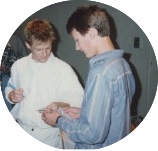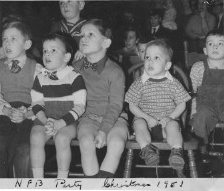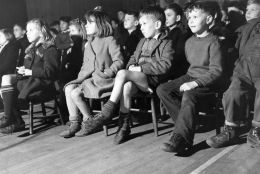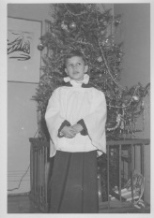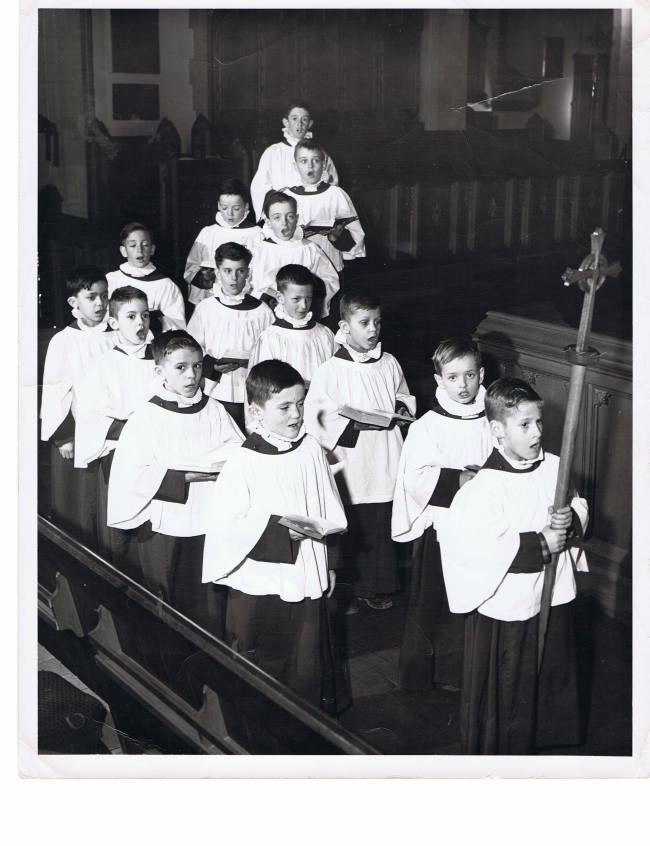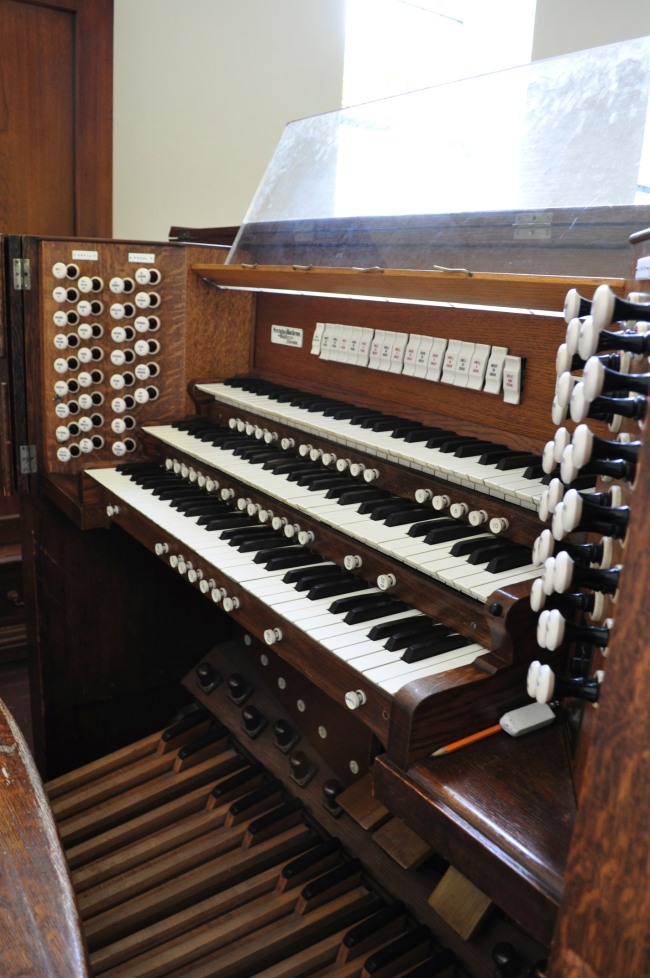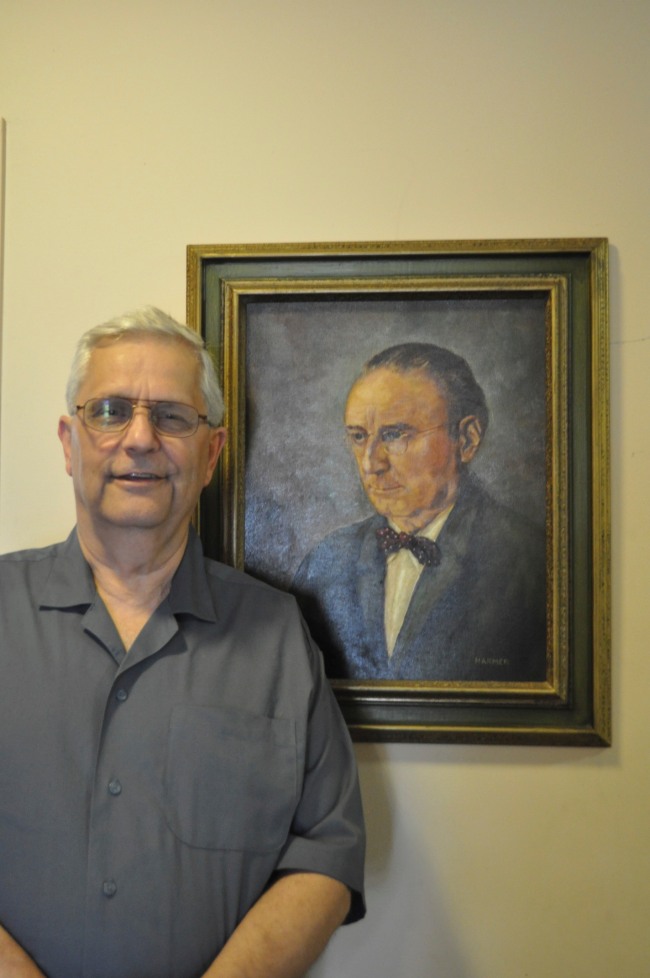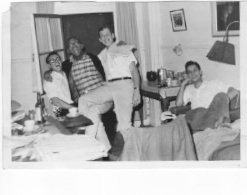We are approaching the end of George’s Roadhouse, at least as we have known it for many years. Sometimes known as George’s Fabulous Roadhouse, particularly when it was successfully being hyped for CBC 3’s national-recognition contest a few years ago, George’s has long been the happening place in Sackville, New Brunswick for music. It is slated to close for good, although I understand that there is a chance that it might still be available for musical events on a spot basis. This then seems an opportune time to reflect on my own favourite musical experiences at George’s.
George’s is right across the road from the once important and busy, but now little visited and completely unstaffed, train station in Sackville, New Brunswick. (The station is now closed, although the train still stops here. Baggage handling is done by on-train personnel.) The building in which George’s is located, the remaining bottom floor of the Intercolonial Hotel, also known as the Sackville Hotel, was erected for A.W Dixon more than 100 years ago, to replace the earlier Intercolonial Railway Hotel, which had burned down as the result of a fire at the nearby Enterprise Foundry. The newer Intercolonial Hotel was still intact, although not occupied, when we moved to Sackville in 1978. Not long afterwards, the building was converted to what became known as Steve’s Tavern, and later George’s Roadhouse. Back in the day, we would sit on the front deck of Steve’s/George’s of a Friday summer afternoon, waiting for it to open, so that we might continue to debrief one another on the latest atrocities at Mount Allison and engage in often heated debate as to what one must do to set the world right, while we ate burgers and fries, or fish and chips, and consumed beer. While we waited for the doors to unlock, we were afforded a pleasant and somewhat becalming view of the area around the edges of the Tantramar Marsh, where it meets the Chignecto Basin. The old Sackville ship-building area is visible from the deck as well. Immediately behind and beside George’s can be seen the remnants of the Enterprise Foundry operation, which suffered another fire a few years ago.
Janet Crawford has clarified for me the details of the sequence of bars in this space. First was the men’s only Sackville Tavern. After being sold to Steven Boorne, it became known as Steve’s Tavern. Later it was bought by George Brown, and was renamed George’s Roadhouse. Subsequently, Mike Wheaton took over, and decided that the name George’s worked just fine. Mike’s brother Darren subsequently took over the operation of George’s, after Mike died. Darren also owns and operates Ducky’s, another bar in downtown Sackville. The name “Darren’s” wouldn’t have worked for the place, I suspect. By the same token, if I were ever to follow up on my joke that I would open up a jazz/blues/folk club in my dotage, I rather suspect “Berkeley’s Hideaway” would not wash either. (Speaking of Sackville establishments carrying the proprietor’s first name, a hole in the wall operation introduced within what was then Steve’s offered, for a time, Joey’s Pizza, before that nascent and ultimately highly successful local business moved out and into progressively larger and better appointed venues on both Bridge and York Streets.)
As the photo below illustrates, George’s is somewhat unprepossessing in outside appearance. As for the inside, well it is pretty grungy too, but that is part of its charm.
I suggested to a friend that the combination of visiting band names appearing on the sign at the time this photo was taken might serve him well in his impending re-election campaign, but for some reason he thought better of it.
George’s, which has an official capacity of 225, has been the site of many a (Thursday) wing night, Friday night supper, and Sunday morning breakfast. There have also been long established and regular seasonal celebrations therein. Examples are the Mount Allison University Fine Arts students’ Hallowe’en costume parties, Boxing Day visits from the Ray Oliver Band, and Good Friday extravaganzas involving the oddly charismatic Sam Moon and his retinue. George’s exudes a casual and friendly atmosphere, albeit one with an underlying odour of wide-eyed young people on the make and somewhat sardonic old people on the bottle and who knows what else.
The dress code at George’s is that there is no dress code, or rather, the implicit folkway is that one should be attired casually. An exception might be made if one were over-dressed with obviously ironic intent. I once went in there wearing a red Ottawa Hunt Club sports jacket that had belonged to my father. I had put it on for official duties in connection with an afternoon Christmas function of the Sackville Community Preschool Association, a no cost/low cost kindergarten provided in town before public kindergarten existed in the province. A Mount Allison colleague, already ensconced at his usual table at George’s, was heard to grumble that by my very propinquity to him in that ridiculous get-up I had destroyed his long-cultivated credibility with the locals.
There have been times when I have been somewhat concerned to witness obviously unwanted attentions being pressed at George’s, and have made subtle interventions, when I deemed it wise. I am not necessarily referring to alcohol-lubricated petitioning for sexual liberties to be taken, although that has certainly happened. One time, a colleague was being accosted by a somewhat inebriated student who evidently had just learned of the consequences he was slated to suffer as a result of some significant transgression on which the University Judicial Committee had ruled. My colleague sat on that committee, and the aggrieved student defendant did not seem to appreciate that by approaching her somewhat belligerently and under the influence, on what was after all “neutral territory” and during what were the dark hours of the night, he was crossing a line. My sidling over, saying not a word, was enough for him to calm down and back off. Believe me, this was not because I strike an imposing figure. I think the presence of a third party made it more obvious to him that he was behaving inappropriately. It was reported to me that, later on that evening, the two individuals involved were able to have a reasonably friendly discussion. As you will have gathered from these two stories, George’s crowds are a mix of town and gown, student and faculty, and young and old.
As for the music at George’s, it has ranged from country music – the shit kickin’, the bluegrass, the honkey tonk, the new, and the alt- varieties – to undergraduate singer/songwriter guitarists of the folkish persuasion, to rock musicans, to alternative music practitioners, to singers of sea shanties, to blues players, to jazz artists, to slam poets, and it goes on and on. George’s has done a good job of presenting both up and coming and established local and regional acts of various types over the years.
Since 2001, there have been as many as ten Tantramarsh Blues Society offerings a year in town, with perhaps 75 in all at George’s itself since 2001. There have also been three Catbird Jazz Society presentations there. (Catbird is a now relatively inactive TBS spinoff group.) As well, there have been fundraisers for many and varied worthy causes over the years. Some couples have held wedding and anniversary dinners at George’s. We attended a 60th birthday party there once, when a potluck house party was correctly estimated to be of sufficient general interest to warrant a change of venue. (More about that, later.) Interestingly, the Rotary Club has met at George’s for a number of years, at some ungodly early hour on Thursday mornings. Recently I learned that the Rotary Club had installed the ramp at the front of George’s, at least in part to serve the needs of one of its stalwarts, a retired faculty member who had had a major stroke. This ramp has since served to make it easier for quite a few people, including me, as I sought to get in and out for various events during the months immediately after I had had bilateral knee installation done. (I thought this ironic since as a critical sociologist by training I am a self-professed developer of what Peter L. Berger called “non-Rotarian insights”.)
There have been many great blues presentations at George’s, and they attract an interesting mix of town and gown, student, faculty and staff, locals and visitors, young and old, and Anglophones and Francophones. In the wintertime, when many of the blues events occur, some of us keep track of Saturday night hockey games during TBS events with our mobile devices, particularly in my case when Les Glorieux are participating in the playoffs, so that one of our interests does not preclude pursuing the other. The organizers of the TBS presentations typically offer pot luck dinners to the performers, which also gives us the opportunity to chat with them about life on the road, other musicians, family, politics, and the like. There have been some interesting experiments with food associated with the TBS events themselves, including a number of occasions on which there was barbecue brought into George’s. (The beans were particularly good.)
The most memorable blues concerts, for me, have been the ones by Guy Davis (six times, counting an upcoming one in April, and I am sure it will be memorable), Garrett Mason (six times as leader, at least twice as a sidesman), Hot Toddy (three or four times at George’s), Roomful of Blues (twice), Toni Lynn Washington (featuring Sax Gordon) (twice), Debbie Davies (twice), The Holmes Brothers, Duke Robillard, Harry Manx, Ray Bonneville, Harrison Kennedy, Ruthie Foster, Delta Moon, Charlie A’Court, E.C. Scott and Smoke, Sugar Ray (Norcia) and the Bluetones (featuring Monster Mike Welch), the Bob Margolin Band (featuring the impressively limber Nappy Brown), Tad Robinson with the Bruce Katz Band, the Nighthawks, and Fathead. Some of the other blues acts we have seen there include Anthony Gomes (twice), Mississippi Heat (twice), Dutch Mason, Big Bill Morganfield (for the non-cognoscenti, a son of Muddy Waters), Theresa Malenfant, Eddie Kirkland, Larry McRay, Joe Louis Walker, Kelly Joe Phelps, Johnny Rawls, the Larry Garner Band, the Lurrie Bell Band, the Jimmy Burns Band, the J-W Jones Band, the Grady Champion Band, the W.C. Clarke Blues Revue, John Primer, Michael Powers, Paul Reddick and the Sidemen, Alvin Youngblood Hart, Jack De Keyzer, Watermelon Slim, Isaac and Blewett, Slick Ballinger, Paul Rishell and Annie Raines, Sue Foley and Peter Karp, Moreland and Arbuckle, Li’l Brian and the Zydeco Travellers, Terry Gillespie (with Bill Stevenson, Tom Easley, and Jeff Arsenault), Joe Murphy, Shirley Jackson (without her Good Rockin’ Daddys), Corey Harris and the 5×5 Band, Sugar Blue Band, and the Mellotones. There were also a few blues acts at George’s that we missed: Shakura Said, Preston Shannon, Bryan Lee and the Blues Power Band, the Andrew “Jr. Boy” Jones Band, the James Armstrong Band, and the Syl Johnson Band. Other artists, specifically John Cambelljohn, Dutch Robinson, the preternaturally talented Carlos del Junco, the rising Matt Anderson, the poignantly intense Charles Bradley with the Menahan Street Band, and Monkey Junk, those slick inducers of the shaking of Sackvillian booty, have all performed for TBS elsewhere in town, with the collaboration of the Town of Sackville, SappyFest, or Mount Allison University. On January 31st, TBS welcomed Nathan and the Zydeco Cha Chas to George’s, and Nathan Williams was impressive, although I would have liked to have seen him stick to the zydeco. The intriguingly named Candye Kane and the great artist Guy Davis are to come later in the term.
Guy Davis, the most frequent of our George’s blues visitors, and for good reason, is the son of Ruby Dee and Ossie Davis, the latter the only person to speak at both Martin Luther King and Malcolm X’s funerals. Guy is from a show business family, then, and was I suspect raised in a heady atmosphere of the theatre, civil rights, social activism, and generally trying to do the right thing. He is also an actor, and, like his “Uncle” Pete (Seeger, that is) a great story-teller. Guy is for me the foremost living exponent of the Piedmont picking style of blues guitar, and he is also a great banjo picker, and an harmonica player reminiscent of Sonny Terry. Perhaps reflecting the interests of my youth, I am always happy when TBS brings in a practitioner of the folk blues. Most TBS regulars are looking for the Chicago and Texas styles, or rock-blues, because they want to boogy. Me, I’m a toe-tapper, finger snapper, and head-nodder, not a dancer. Once in a while, I go crazy and rap the table with my fingers. If I like what I hear, I buy at least one CD.
My favorite Guy Davis concert was actually somewhere other than at George’s, at an historical stone church in Paris, Ontario, where one evening he played a purely acoustic and candle-lit concert to about forty people, which is all the church would hold. It was candle-lit because there was no electricity in the building. I just happened to notice that he was playing nearby, when I was visiting my mother in Cambridge and thought to check out what was happening by scanning the local paper. The concert was absolutely magical, despite the presence of an uncomfortable number of mosquitos. This was some time after I had seen Guy once or twice already in Sackville.
The first time, I had come directly to George’s from the Brunton Auditorium on campus, where I had given an introductory talk on my father’s life and his vocal music and then listened to a number of student singers and pianists perform some of his music. I was pretty drained afterwards, but wanted to hear this blues artist that TBS impresario Roopen Majithia had told me I shouldn’t miss. I perked up as soon as Guy started, and was an instant fan. The third time that he played at George’s, we had one our potlucks for him, at the home of one of the TBS organizers, who had actually gone to school with him for a while, in New Rochelle, New York. Linda and I had a chance to talk to Guy a bit about this and that. We even checked out his parents’ old home together with him using the just-recently-introduced Google Earth facility.
Here are two Guy Davis videos, which showcase his vocalizing, guitar-picking, story-telling, and harp blowing-propensities.
That’s No Way to Get Along
Railroad Story
The first time that Guy performed at George’s, he included “Railroad Story,” which happened to coincide with the faint train-horn-blowing announcement of the approach of a Via Rail train, just across the road. I still haven’t figured out whether Guy timed the song’s placement in his set advisedly, having asked someone when the next train would be coming by, or whether it was just a happy coincidence. In any case, it was quite a moment.
The first time I remember seeing Garrett Mason was when Theresa Malenfant appeared at George’s, backed by AJ and the Red Hots, to whom I gather she had just been introduced. Now, I have a prejudice against self-indulgent Janis Joplin imitators, which was the approach Ms Malenfant was seemingly taking that night, and it doesn’t help that I never liked Joplin herself that much. (Sacrilege, I know.) Anyway, between her perhaps put-on cranky stage demeanour, the band’s apparent laxity, and our being right up against one of the speakers, it was not a great night. However, the young guitarist – he looked about 16 – who was rumoured to be the son of Dutch Mason, was pretty good. Later that year, he, and the rest of AJ and the Red Hots backed up Dutchy himself. Mason the elder had kindly agreed to come at the last minute, because an American act had had difficulties getting up here for weather or van-breakdown reasons. (I think it was Big Jack Johnson.) Dutch was in a wheelchair for much of the evening, but his distinctive vocal delivery and his harmonica chops were still there, and quite a few local old-timers were really happy to see him again. Evidently Dutch ran a tight ship, because the band was considerably better than they had been the previous time. They had obviously played with him before, and he had them whipped into shape. Young Garrett was particularly impressive. As mentioned, has been back four times since, and it has been a great pleasure to witness his development as an artist.
Here’s Garrett playing with Keith Hallett.
Diddley Beat
Roomful of Blues is one of the tightest bands I have ever seen. Here’s an example, involving a slightly stripped down version of the unit.
Boogie Woogie Country Girl/Two for the Price of One
Debbie Davies has been on the road for more than thirty years, and has eleven solo albums out. Here’s just one video, a modified nod to Jimmy Smith, that gives an idea of how good she is.
Down at the Honky Shack
Next, a little taste of Sax Gordon and Toni Lynn Washington, both big favourites in town. The first time they came, Gordon wore a gold lamé shirt and tore up the place. Toni Lynn is a remarkable woman and a great performer. The second time they were here, I came to understand some of the harsh realities of life on the road, particularly in New England and Canada during Nor’easter season, when one has to drive for twelve hours or more to get to the next gig, plus suffer the indignities often experienced at the border. (One TBS performer, Li’l Dave Thompson, actually died in an auto accident in February, 2010, on the very last leg of a long road trip that had included Sackville, between Charleston, South Carolina and his home town, Greenville, Mississippi.)
The Delta Moon visit was one where I particularly enjoyed talking to the musicians, about other artists, different kinds of audiences, and, above all, political matters. Unfortunately, their performance at George’s was one of those occasions wherein, since we had poor seats, way at the back of the late-arriving-student and dancing section, and because I have for some years taken to using earplugs for auditory-preservation reasons, I could not hear either the music or the reactions of others as well as I would have wished. Somehow, though, I sensed that I should buy the CD, and it is one that I still enjoy listening to regularly. The members of Delta Moon enjoy touring in Canada, in part because we still listen to the music up here, so if you have a chance to catch them, I would recommend that you try.
Hellbound Train
I had never heard of The Holmes Brothers until Roopen told me they were coming to George’s for TBS in early 2008. I was completely blown away by that concert. It was, for me, the highlight of all of my experiences at George’s. The Holmes Brothers personify roots music, combining r&b, soul, blues, funk, gospel, and country in an irresistible amalgam. I bought the 2007 State of Grace CD that night, and since then have acquired quite a few others.
Here are links to a couple of audio clips from State of Grace, “I Want You to Want Me” and the Nick Lowe classic, “What’s So Funny About Peace, Love and Understanding?”. I have also embedded three tremendous Holmes Brothers videos from YouTube. If you were to confine your video viewing to one, I would make it “Amazing Grace”.
I Want You to Want Me http://www.youtube.com/watch?v=FPNhnIwT920
What’s So Funny http://www.youtube.com/watch?v=csl-X6F7s0k
Feed My Soul (with Joan Osbourne)
Amazing Grace
You’re The Kind of Trouble
I wish I had taken the opportunity to talk to them while they were here, especially Wendell, the lead singer and guitarist. I would crawl over broken glass to have a chance to see them again.
Catbird Jazz Society presentations at George’s have included the Michel Donato Trio, featuring the remarkable Marin Nasturica (see my blog entry on “squeeze-box jazzers”), the Salsa Snow Fiesta, with Latin Groove (and a Caribbean Dinner), and Gypsophilia. These events were artistic successes, particularly the Michel Donato Trio one, but the financial results were decidedly mixed. (See blog entry on my various adventures as a presenter.)
The 60th birthday party to which I alluded off the top involved an outstanding performance by Stephen Fearing, who has been to Sackville a few times, including several with Blackie and the Rodeo Kings. In this instance, Stephen performed alone, and through this event I finally realized how good he really is on guitar. (Since BARK involves Colin Linden, it tends to be primarily Stephen’s voice that one notices when they perform.) The following number displays both his vocal and instrumental prowess.
The Man Who Married Music
And there you have it. It will be a sad day when George’s closes its doors for good. But, as I said, there is still a chance that that day is not yet nigh.
Berkeley Fleming
Sackville, N.B.




